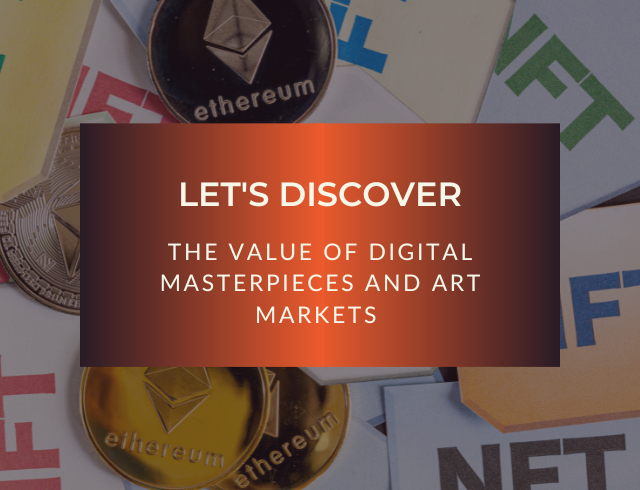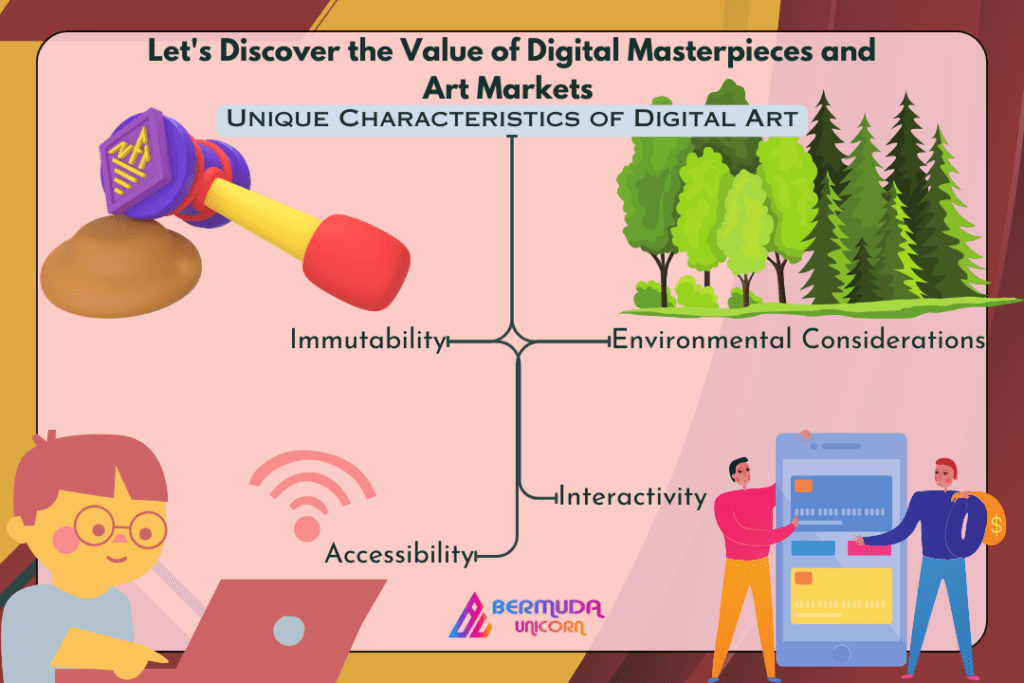![]()

The world of art has always been a realm of constant evolution and transformation. From traditional paintings and sculptures to conceptual and performance art. Also, the art market has adapted to various mediums and styles over the years. However, one of the most significant and disruptive shifts in recent times has been the emergence of digital art and the market’s new frontier in discovering the value of digital masterpieces.
Digital art, often created using software, algorithms, and various digital tools, has been around for decades. But it wasn’t until the advent of blockchain technology and non-fungible tokens (NFTs) that digital art truly began to capture the imagination of artists, collectors, and investors. NFTs provide a way to authenticate and establish ownership of digital artworks, creating scarcity in a digital world and enabling artists to monetize their creations in a new and innovative manner.
The Rise of NFTs
NFTs are unique digital tokens that represent ownership of a specific digital asset, be it an image, video, music file, or any other digital creation. These tokens are stored on a blockchain, which is a decentralized, immutable ledger. The blockchain records the ownership and provenance of the digital asset, making it tamper-proof and easily transferable between owners. This technology has provided a solution to one of the major challenges in the art world: provenance and authenticity.
Digital artists can now create, sell, and distribute their works as NFTs, allowing collectors and enthusiasts to buy and trade digital art with confidence, knowing they own a unique, authenticated piece. This has opened up new avenues for artists to gain recognition and income.
Unique Characteristics of Digital Art
Digital art has several unique characteristics that set it apart from traditional art forms:
1. Immutability:
Once a digital artwork is tokenized as an NFT, it is recorded on a blockchain, making it immutable. This means that the ownership and history of the piece are permanently recorded and cannot be altered.
2. Accessibility:
Digital art is highly accessible. It can be easily viewed and appreciated on a wide range of devices, from smartphones and tablets to computers and digital frames. This accessibility has broadened the reach of artists and collectors.

3. Interactivity:
Digital art can incorporate interactive elements, such as animations, sound, and user engagement. This dynamic quality can create a deeper connection between the artist and the audience.
4. Environmental Considerations:
Digital art has a smaller environmental footprint compared to traditional art forms. There are no physical materials, transportation, or storage costs associated with digital pieces, making it a more sustainable choice.
The Digital Art Market
The digital art markets has seen exponential growth in recent years, attracting attention from both seasoned art collectors and a new generation of tech-savvy buyers. Some notable digital art sales, such as Beeple’s “Everyday: The First 5000 Days” selling for $69 million in a Christie’s auction, have brought digital art into the mainstream.
While some critics argue that the value of digital art is inflated and speculative, it’s essential to recognize that art’s value has always been a matter of subjective judgment. The value of art lies in its cultural, emotional, and aesthetic significance, which also applies to digital art. The fact that the market is driven by collectors who find meaning and value in digital pieces is a testament to the enduring power of art.
Additionally, the digital art markets is more inclusive than traditional art markets, as it enables artists from diverse backgrounds to gain recognition and financial support. Emerging artists who may not have had the opportunity to exhibit their work in traditional galleries can now enter the art world through digital platforms and NFT marketplaces.
The Challenges and Controversies

As with any new frontier, the digital art markets faces its share of challenges and controversies. Some of these include:
1. Copyright and Plagiarism:
The ease of digital replication has raised concerns about copyright infringement and plagiarism. Artists and collectors need to be vigilant in protecting their intellectual property.
2. Environmental Concerns:
While digital art has a smaller environmental footprint than traditional art, the energy consumption associated with blockchain transactions, especially on some networks like Ethereum, has drawn criticism.
3. Speculation and Hype:
The rapid rise of NFTs has attracted speculators who may not have a genuine interest in art but are looking to profit from the hype. This can lead to inflated prices and volatility in the markets.
4. Digital Preservation:
Ensuring the long-term preservation of digital art is a challenge, as file formats and storage technology evolve. Proper archiving and preservation methods are still being developed.
The Future of Digital Art
The art market’s new frontier in digital art and NFTs is undoubtedly an exciting development. It represents a significant shift in how we create, consume, and value art. As the markets continue to evolve, we can expect to see a growing acceptance of digital art as a legitimate and valuable form of artistic expression.
Artists, collectors, and enthusiasts need to engage in conversations about the value of digital art and ensure that it maintains its integrity and authenticity. As the market matures, it will likely address some of the challenges it currently faces, such as copyright issues and environmental concerns.
The future of digital art holds endless possibilities. With technology continuing to advance, we can anticipate new forms of digital art that push the boundaries of creativity and innovation. The digital art market’s new frontier is not just a trend; it is a revolution that is redefining the art world, opening doors to artists and collectors alike, and inviting us to explore the boundless possibilities of the digital canvas.
Frequently Asked Questions (FAQs)
1. What is digital art?
– Digital art refers to artwork created using digital tools, software, and technologies. It can encompass a wide range of forms, including images, animations, 3D models, and interactive pieces.
2. What are NFTs, and how do they relate to digital art?
– NFTs, or non-fungible tokens, are unique digital tokens that represent ownership of a specific digital asset, such as digital art. They are stored on a blockchain and provide a way to prove the authenticity, rarity, and ownership of digital creations.
3. How do I buy and collect digital art as an NFT?
– To buy digital art as an NFT, you typically need to set up a digital wallet compatible with the specific blockchain where the NFTs are created (e.g., Ethereum). You can then browse NFT marketplaces, bid on or purchase digital art pieces using cryptocurrency.
4. What gives digital art value?
– The value of digital art, like traditional art, is subjective. It can be influenced by factors such as the artist’s reputation, the uniqueness of the piece, the cultural and emotional significance, and the demand from collectors and enthusiasts.
5. Are NFT prices inflated, and is it a speculative bubble?
– The digital art markets has experienced rapid price increases and speculative behavior, which has led to some concerns. However, the value of art has always been a matter of personal interpretation, and while there may be speculative activity, genuine interest and value in digital art also exist.
